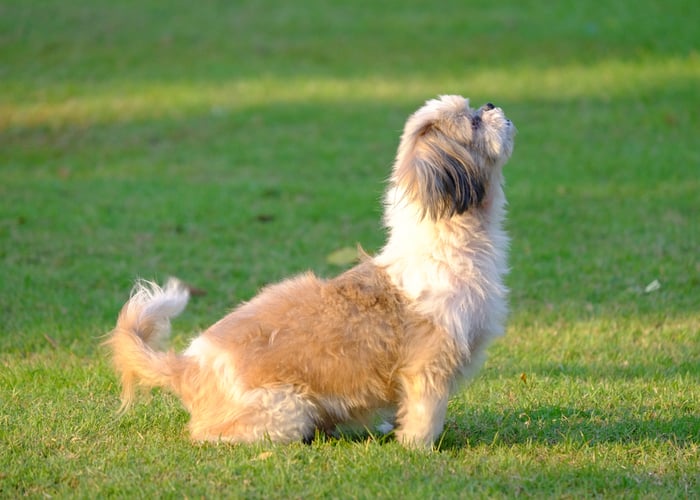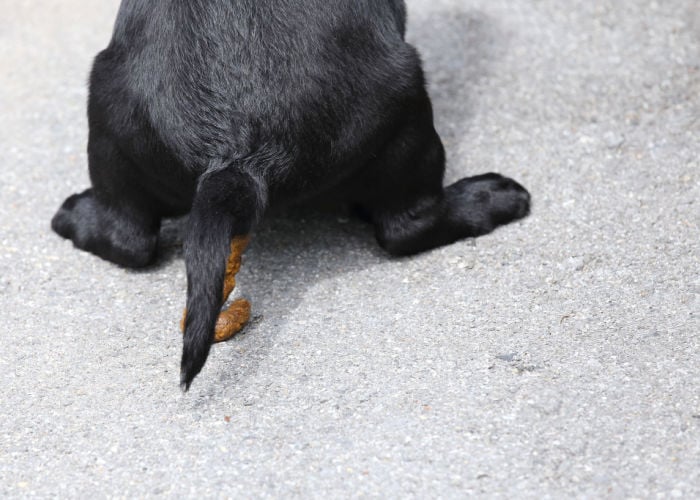Since you clicked on this article, you must have seen your dog scoot his butt across the floor recently. Maybe he’s even done it multiple times. Either way, it has you wondering “Why does my dog scoot his butt on the floor?”
Butt scooting in dogs is a common behavior. It may seem strange, and even a little bit gross to you, but it’s completely normal.
Butt scooting is a sign that your dog needs your attention. It could be brought about by many different things, most of which will need some sort of treatment.
If you have an itch or irritation somewhere on your body, you can likely reach to scratch it or adjust to make yourself more comfortable. Your dog doesn’t have that luxury, so he needs to find other ways to fix the issue.
When Fido has an itch on his back, you may see him rolling around on your carpet trying to scratch it. If he’s having a problem near his rear end, he’s going to do the same thing.
This article will explain possible reasons to answer the question why does my dog scoot his butt on the floor, and also tell you how to resolve these problems quickly.
Why Does My Dog Scoot His Butt On the Floor?

1. Parasites
This is the most common reason for this dog health issue. Parasites, like worms, are released from the body through the anus, which can be itchy and uncomfortable for your pet.
Look for signs of parasites in your dog’s poop or around his bedding. They may look like small worms or tiny grains of rice.
Even if you don't see signs of worms, there is still a chance that your dog is suffering from an infestation. If your dog continues scooting for more than 48 hours, be sure to make an appointment with your veterinarian to have him checked out.
2. Clogged Anal Glands
Dogs have two small anal glands on either side of their anus. These glands contain a foul, fishy-smelling liquid that is released when your dog poops.
Firm stools will trigger the anal glands to empty on their own. If your dog suffers from frequent loose stools or if the glands aren't working properly, the fluid in these anal sacs can build up.
When the sacs do not get emptied properly, for whatever reason, the fluid can begin to solidify. This will be painful or, at the very least, uncomfortable for your dog. If left untreated, the anal sacs can become infected, causing more serious health issues.
Trauma to the anal sacs can also cause them to be clogged. If someone tries to express the glands, and they don't perform the task properly, this could do a lot of damage.
You may actually be able to see the enlarged glands by inspecting your dog's rear end. If you notice that the glands look enlarged, consult your veterinarian. Likewise, if you believe that your dog's anal sacs are clogged or you notice blood in his stool, be sure to consult your veterinarian immediately before more serious health issues begin.
Your vet may recommend trying a warm compress and/or antibiotic ointment. He may also want to see your pet in the office to have the glands expressed by a professional.
MORE: Dog Anal Gland Problems – Signs, Causes and Treatments

3. Skin Irritation
The skin around your dog's rear end could be irritated for a number of reasons. Clipper burn or irritation from grooming products is a common cause.
Fleas, skin allergies or even dry air could cause irritation to the sensitive skin on your dog's hind end. Female dogs may also scoot their butts when there is irritation of the vulva, caused by a UTI or other health issue.
If your dog scoots his butt across the floor once or twice, he’s probably just scratching an itch or addressing something that is making him uncomfortable. If he does it quite often, you should see your veterinarian to make sure there isn’t a more serious issue.
4. His Butt Is Dirty
Dogs cannot clean themselves after going number 2 the way that humans can. Sometimes there is a mess left behind, and your dog may scoot to try to remove the feces.
If your dog has longer fur, loose stool can get stuck to the fur causing irritation and itching. It may sound gross, but if your dog is scooting, the first thing you should do is examine his rear end.
If it needs to be cleaned, use grooming wipes or a cloth with warm water to remove fecal matter. If you notice mats in his fur, you’ll need to remove them with scissors or clippers.
Be sure to keep up with grooming in this area to prevent the problem from happening again.
READ NEXT: How To Make A Dog Poop Quickly












